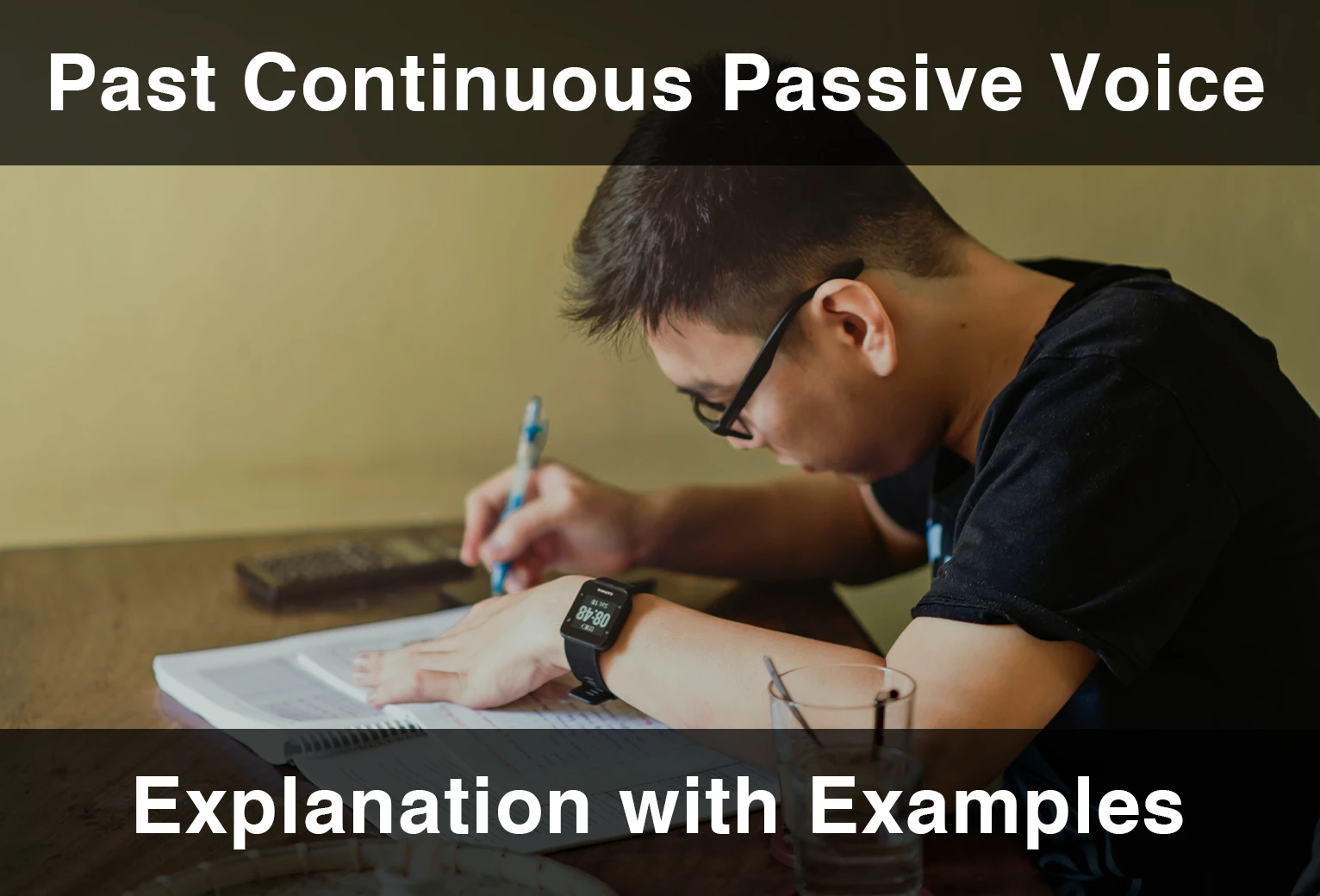The present continuous tense, also known as the present progressive tense, is an essential aspect of English grammar. It is used to describe actions that are happening at the present moment or around the current time. We can use passive voice with Present Continuous Tense in our sentences to direct the focus of the sentence on to the action rather than the subject.
How to Make Present Continuous Tense Passive Sentences
Passive voice is a quality of a verb that describes when the subject of a sentence is acted upon by the verb. It is used when the focus is on the action or the object of a sentence rather than the subject. It is not important or not known who or what is performing the action. In passive voice, the sentence is interpreted from the perspective of the one who experiences the action, not the one who does it. To form present continuous tense passive sentences, we follow these steps:
Start with an object.
Add “am/is/are” + “being”.
Use the past participle (third form) of the verb as the main verb.
Add “by” + subject of the active sentence.
Present Continuous Tense Positive Passive Sentences
Passive voice is a quality of a verb that describes when the subject of a sentence is acted upon by the verb. We use it when the focus is on the action or the object of a sentence rather than the subject. To form present continuous tense positive passive sentences, we follow these steps:
We start with an object.
We add “am/is/are” + “being”.
We use the past participle (third form) of the verb as the main verb.
Finally we add “by” + subject of the active sentence.
The structure formula is:
Object + am/is/are + being + past participle of the verb + Subject
Active voice: He (object) + is + throwing (Verb + -ing) + the ball (Object).
Passive voice: The ball + (Object) is being + thrown (Past participle) (by him).
Positive Sentences
| Object | Pronouns + being | Main Verb | By | Subject |
|---|---|---|---|---|
| Object | Am/is/are + being | Past participle of the verb (V3) | By | I |
| Object | Am/is/are + being | Past participle of the verb (V3) | By | You |
| Object | Am/is/are + being | Past participle of the verb (V3) | By | We |
| Object | Am/is/are + being | Past participle of the verb (V3) | By | They |
| Object | Am/is/are + being | Past participle of the verb (V3) | By | He |
| Object | Am/is/are + being | Past participle of the verb (V3) | By | She |
| Object | Am/is/are + being | Past participle of the verb (V3) | By | It |
Present Continuous Tense Positive Passive Examples:
Here are some positive sentence examples in Present Continuous Tense Passive voice.
Active voice: Laura is teaching math at high school.
Passive voice: Math is being taught by Laura at high school.
Active voice: They are making a show about him.
Passive voice: A show about him is being made (by them).
Active voice: A waiter is serving food in this restaurant.
Passive voice: Food is being served by a waiter in this restaurant.
Active voice: They are taking quizzes for different people.
Passive voice: Quizzes are being taken for different people (by them).
Active voice: The police are forcing him to quit right now.
Passive voice: He is being forced to quit (by the police right now).
Active voice: Everybody is watching the movie .
Passive voice: Movie is being watched by everyone.
Present Continuous Tense Negative Passive Sentences
Passive voice is a quality of a verb that describes when the subject of a sentence is acted upon by the verb. We use it when the focus is on the action or the object of a sentence rather than the subject. We use “not” in the sentence after “am/is/are” to make it negative.To form present continuous tense negative passive sentences, we follow these steps:
Start with an object.
Add “am/is/are” + “not” + “being”.
Use the past participle (third form) of the verb as the main verb.
Add “by” + subject of the active sentence.
The structure formula is:
Object + am/is/are + not being + past participle of the verb + Subject
Active sentence: “I am not eating a burger.”
Passive sentence: “A burger is not being eaten (by me).”
Negative Passive Sentences
| Object | Pronouns + being | Main Verb | By | Subject |
|---|---|---|---|---|
| Object | Am/is/are + not being | Past participle of the verb (V3) | By | I |
| Object | Am/is/are + not being | Past participle of the verb (V3) | By | You |
| Object | Am/is/are + not being | Past participle of the verb (V3) | By | We |
| Object | Am/is/are + not being | Past participle of the verb (V3) | By | They |
| Object | Am/is/are + not being | Past participle of the verb (V3) | By | He |
| Object | Am/is/are + not being | Past participle of the verb (V3) | By | She |
| Object | Am/is/are + not being | Past participle of the verb (V3) | By | It |
Present Continuous Tense Negative Passive Examples:
Here are some negative sentence examples in Present Continuous Tense Passive voice:
Active voice: Laura is not teaching math at high school.
Passive voice: Math is not being taught by Laura at high school.
Active voice: They are not making a show about him.
Passive voice: A show about him is not being made (by them).
Active voice: A waiter is not serving food in this restaurant.
Passive voice: Food is not being served by a waiter in this restaurant.
Active voice: They are not taking quizzes for different people.
Passive voice: Quizzes are not being taken for different people (by them).
Active voice: The police are not forcing him to quit right now.
Passive voice: He is not being forced to quit (by the police right now).
Active voice: Everybody is not watching the movie .
Passive voice: Movie is not being watched by everyone.
Passive Questions in Present Continuous Tense
To make interrogative passive in present continuous tense, you can follow these steps:
We start with “am/is/are”
We add “being” + past participle (third form) of the verb as the main verb.
We add by + subject at last
For example:
a) Is a burger (Object) + being (be + V-ing) + eaten (Past participle) + by me (by + subject) ?
b) Yes, I am eating a burger. The burger is being eaten by me.
Passive Interrogative Sentences
| Pronouns | Object | Being + Main Verb | By | Subject |
|---|---|---|---|---|
| Am/is/are | Object | Being + Past Participle of the verb | By | I |
| Am/is/are | Object | Being + Past Participle of the verb | By | You |
| Am/is/are | Object | Being + Past Participle of the verb | By | We |
| Am/is/are | Object | Being + Past Participle of the verb | By | They |
| Am/is/are | Object | Being + Past Participle of the verb | By | He |
| Am/is/are | Object | Being + Past Participle of the verb | By | She |
| Am/is/are | Object | Being + Past Participle of the verb | By | It |
Present Continuous Tense Passive Interrogative Examples:
Here are some positive passive interrogative examples in Present Continuous Tense:
Is the dinner being cooked by the cook?
Are the newspapers being read by the elders?
Is the motorcycle being washed by the man?
Is the mansion being cleaned by her?
Is the garbage being thrown by the maid?
Am I being robbed right now?
Are the animals being killed by the hunters?
Are the dishes being washed by the man?
Is the club being closed tonight?
Is the bug being fixed by the senior?
Negative Passive Interrogative sentences in Present Continuous Tense
Negative passive interrogative sentences in present continuous tense are formed by adding “not” or “n’t” after the verb “be”.To form negative passive interrogative in present continuous tense, you can follow these steps:
We start with “am/is/are” .
We add “not being” + past participle (third form) of the verb as the main verb.
We add by + subject at last.
For example:
a) Is the burger (Object) + not being (be + V-ing) + eaten (Past participle) + by him (by + subject) ?
b) The burger is not being eaten by him.
Negative Passive Interrogative Sentences
| Pronouns | Object | Not being + Main Verb | By | Subject |
|---|---|---|---|---|
| Am/is/are | Object | Not Being + Past Participle of the verb | By | I |
| Am/is/are | Object | Not Being + Past Participle of the verb | By | You |
| Am/is/are | Object | Not Being + Past Participle of the verb | By | We |
| Am/is/are | Object | Not Being + Past Participle of the verb | By | They |
| Am/is/are | Object | Not Being + Past Participle of the verb | By | He |
| Am/is/are | Object | Not Being + Past Participle of the verb | By | She |
| Am/is/are | Object | Not Being + Past Participle of the verb | By | It |
Present Continuous Tense Negative Passive Interrogative Examples:
Here are some negative passive interrogative examples in Present Continuous Tense:
Is the dinner not being cooked by him?
Are the newspapers not being read by the citizens?
Is the motorcycle not being washed by the owner?
Is the mansion not being cleaned by her?
Is the garbage not being thrown by the maid?
Short answers in Present Continuous Tense Passive
To give short answers to Passive Present Continuous Tense Questions, we write “Yes/No, subject + pronouns”. Here are some tables and examples to help you better understand.
Positive Answers:
| Confirmation word | Subject | Pronouns |
|---|---|---|
| Yes | I | Am/is/are |
| Yes | You | Am/is/are |
| Yes | We | Am/is/are |
| Yes | They | Am/is/are |
| Yes | He | Am/is/are |
| Yes | She | Am/is/are |
| Yes | It | Am/is/are |
Is the dinner being cooked by the cook? / Yes, it is.
Are the trees being cut ? / Yes, they are.
Is the letter being sent? / Yes, it is.
Negative answers:
| Denial word | Subject | Pronouns + not |
|---|---|---|
| No, | I | Am/is/are + Not |
| No, | You | Am/is/are + Not |
| No, | We | Am/is/are + Not |
| No, | They | Am/is/are + Not |
| No, | He | Am/is/are + Not |
| No, | She | Am/is/are + Not |
| No, | It | Am/is/are + Not |
Is the dinner being cooked by the cook? / No, it isn’t.
Are the trees being cut ? / No, they aren’t.
Is the letter being sent? / No, it isn’t.
Wh- Questions in Present Continuous Tense Passive
To ask for more specific information, we can include question words in our passive voice questions. These question words include “who, what, where, when, how etc.”. To ask a passive question in Present Continuous Tense with these question words, we need to follow this simple formula:
Wh- questions + am/is/are + subject + being + past participle of the main verb (V3) + by + object + ?
| Question Word | Pronouns | Subject | Auxiliary Verb | Verb | By + Complement |
|---|---|---|---|---|---|
| Who, what, where, when, how | Am+Is Are | He/She/It | Be+ing | V3 | Object |
| You/We/They |
Here are some examples of Wh- question sentences in Present Continuous Tense Passive:
Why are we being called?
How are they being seen ?
Why are we being canceled ?
Why is she being thrown out of the game ?
What are we being told?
Frequently Asked Questions About Present Continuous Passive Voice
What are some examples of Present Continuous Passive Voice sentences?
Here are some examples for Present Continuous Passive voice sentences:
A show about him is being made.
Math is being taught by Laura at high school.
The bananas are being eaten.
What are some examples of negative Present Continuous Passive Voice sentences?
Here are some examples for negative Present Continuous Passive voice sentences:
Math is not being taught by Laura at high school.
He is not being invited by them.
The computer is not being fixed.
What are some examples of interrogative Present Continuous Passive Voice sentences?
Here are some examples for interrogative Present Continuous Passive voice sentences:
Is the food being cooked?
Are the trees being cut?
Is the letter being sent?
What is the difference between active voice and passive voice?
In an active voice, the subject is performing the action. It is always known who is doing the action. In a passive voice, the subject is the receiver of the action. It is not always clear who is doing the action. To give the information about the carrier of the action, we use the preposition “by” followed by the agent of the action.
Would you like to put what you have learned into practice? You can access everything you need to learn English on a single platform! With 25-minute one-on-one live English lessons, 40-minute group lessons, more than 30,000 interactive videos, vocabulary learning tools, AI-supported tutor MiMi, quizzes, and interactive activities, EnglishCentral offers its users a personalized and quality education plan at an affordable price. How about registering for EnglishCentral now and starting to learn English?











